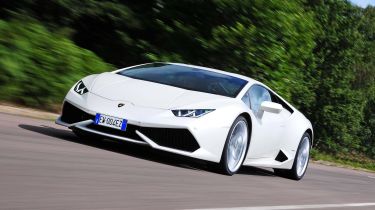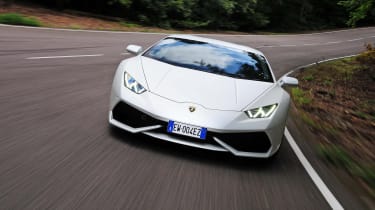Lamborghini Huracan review - Engines, performance and drive
The Huracan is fast and loud, but the 4WD model isn't as good in corners as the 2WD model

Lamborghini has used the might of the VW Group engineering department to pack the Huracan with the very latest technology. The aluminium and carbon-fibre chassis is 10 percent lighter and 50 percent stiffer than the Gallardo’s, while adaptive damping is available as an option and the electromechanical steering varies its ratio depending on your speed.
The electronically-controlled four-wheel-drive system sends 70 percent of power to the rear in normal operation, but can divert up to 100 per cent to the rear if it senses slip at the front. Plus, there’s a new Lamborghini Dynamic Vehicle Integration (LDVI) function, which is basically the technological brain of the EVO, capable of coordinating the driving dynamics based on the driver's input, external environment and the selected driving mode.
• Lamborghini Huracan Spyder review
Three increasingly aggressive driving modes are selectable via an ANIMA switch on the steering wheel and, perhaps most significantly, the old automated manual box has been ditched in favour of a lightning-fast and perfectly smooth seven-speed twin-clutch transmission - the same as the one found in the Audi R8.
The steering is light and incredibly precise, while the standard carbon-ceramic brakes provide immense stopping power, even after several flying laps on a track.
Used - available now

2023 Lamborghini
Huracan
25,000 milesAutomaticPetrol5.2L
Cash £159,995Push the Huracan to the limits of adhesion, and even in its most aggressive Corsa mode it tends to understeer rather than let the back step out for heroic smoky drifts. It just doesn't feel that adjustable on the limit – in this respect both the Ferrari 488 GTB and McLaren 650S are better.
The rear-wheel drive version is a sweeter handling car than the 4WD model, with more alert responses and greater drivability, thanks in part to a 30kg weight saving.
On the road, the Huracan makes much more sense. With the gearbox in auto and the suspension in its softest setting, it’s more compliant than the Gallardo ever was, and easier to drive day-to-day than any of its rivals. We'd avoid the optional LDS variable-ratio steering system, though; it adds a hint of unpredictability to the Huracan's handling. The standard steering feels cleaner and more precise in its responses.
Engines
The 5.2-litre Audi-sourced V10 now produces 631bhp and 600Nm of torque. It delivers incredible acceleration, along with a deep, growling soundtrack. It takes the Coupe from 0-62mph in 2.9 seconds and on to a 202mph top speed. The Spyder version completes the sprint in 3.1 seconds, with the same maximum.
The rear-wheel-drive Huracan features a slightly detuned version of the same engine, making 601bhp and 560Nm. As a result, and with power only going to the rear wheels, it trails slightly on performance, with a claimed 0-62mph time of 3.3 seconds.









